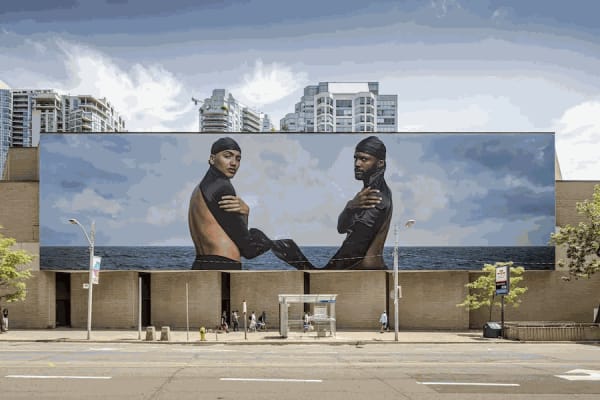Esmaa Mohamoud: The Brotherhood FUBU (For Us, By Us): Scotiabank Photography Festival
Focusing on the physical connection between Black male bodies by amplifying the symbol of the du-rag, Esmaa Mohamoud confronts the dynamics of gender and race. Both of the components of her two-part commissioned project—a massive photographic mural on Bay Street, unveiled in June 2021, and a bronze sculpture installed at nearby Harbour Square Park, unveiled in September 2022—assert a commanding occupation of public space. Foregrounding the powerful symbol of the du-rag, the Toronto- and Markham-based artist opens a dialogue about systemic inequity, while signalling positive change.
Mohamoud’s multidisciplinary practice speaks to the historical precedents that incessantly propagate power imbalances. She explores how racialized bodies navigate complex social, political, and cultural landscapes, as well as the ongoing paradoxes of Blackness—its hypervisibility and invisibility. Addressing the racial disparities that are frequently encountered, performed, and resisted, the African Canadian artist offers a meditative reflection on interpersonal relations as they continue to be reimagined and redefined. For The Brotherhood FUBU (For Us By Us) (2020–22), Mohamoud shifts her focus from the institutional context of a gallery or museum to present her work in civic space—where it is always accessible to all people. Comprised of a photographic image and an interrelated sculpture, her project explores the relationship between two Black male subjects. Standing in the water of Lake Ontario, the men in the photograph are joined to one another with a two-headed du-rag, which is also the subject of the striking new sculpture. Mohamoud describes her project concept:
“Ultimately my goal is to address ideas of Black intimacy and vulnerability in a way that highlights both the closeness and the fragility of Black men. Black bodies are often the focus of a voyeuristic, dehumanizing gaze from non-Black people, and as such, I don’t usually reveal the subject’s face within my works. But in this case, the image’s massive scale shifts the power dynamic and grants the subjects agency and confidence to return the viewers gaze. Looking over their shoulders, the men challenge viewers to consider the ways in which they cast their gaze upon the Black body. FUBU pushes against racialized depictions of Black men—which often focus on the subjects engaged in acts of labour or conflict—by positioning them as boldly united figures asserting their presence in the physical and cultural landscape.“
Placed near the waterfront with its densely populated leisure destinations, Mohamoud’s photographic mural and bronze sculpture will be on display over the span of two years. As people around the globe deface, topple, and remove memorials that venerate the protagonists of racism, enslavement, colonization, and genocide, space is created for authentic narratives to emerge. The Brotherhood FUBU refutes imperialist traditions and offers spirited gestures that celebrate the cultures and communities oppressed by such structures. The work opens critical conversation about the racist systems that require radical change, and it stands for the necessary changes that are, hopefully, on the horizon.
Curated by Bonnie Rubenstein
Supported by the City of Toronto, Cindy and Shon Barnett, Dara and Marvin Singer, Partners in Art (Founding Patron)







